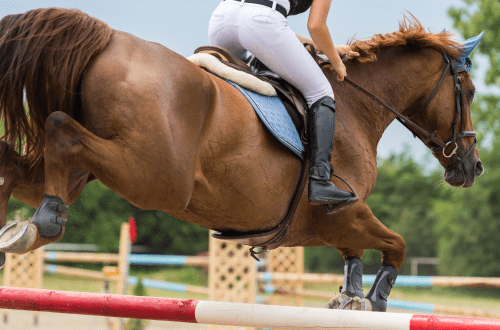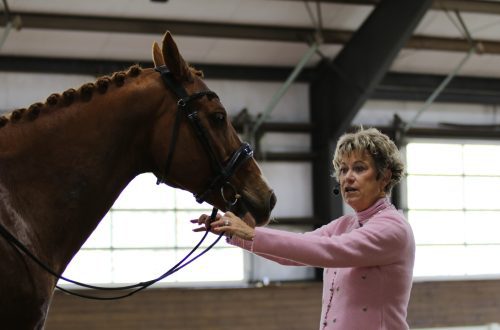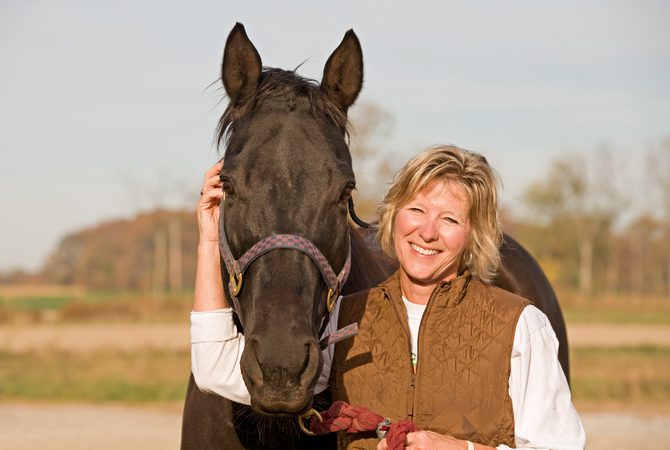
If the horse is shy
If the horse is shy
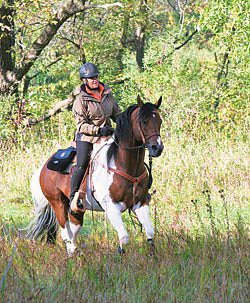
Almost all horses are scared. At the same time, they become shy, sideways, jump to the side, spin around their axis, glow and / or run away. Since horses are prey animals in the wild, this behavior could have saved their lives.
However, when you are on horseback, your horse’s skittish behavior can be detrimental to the safety of both you and your horse. Make your horse more confident by following a few simple tips.
First, evaluate your horse. Is she frightened because she is anxious and timid herself, or is she young and inexperienced? A naturally shy horse is more sensitive and restless than others. It seems that “horse-eaters” lie in wait for her everywhere.
Then think about your own state – your thoughts, fears and anxieties are transmitted to the horse, increasing the likelihood that he will be frightened. If you are afraid your horse will be afraid, then it is most likely that he will be afraid!
But the good news is that if you muster up the courage, ride confidently, and take some time to learn, even the most cowardly horse can be turned into a reliable partner.
“If you own a shy horse, it takes Olympic endurance, time, and many miles in the saddle to fix it,” says top trainer/seminar organizer Lynn Palm. “If you don’t have everything that is required, then most likely you and the horse are not suitable for each other – be realistic.”
To deal with your pleasure horse’s worries, be prudent and plan ahead before you set out to storm your route. Study the places where you will pass, think about what “ambushes” can lie in wait for you, what can scare the horse, evaluate the quality of the ground – where and with what gait you can move. Now, going for a walk, you will not only have to get from point A to point B. You will have one of the types of training.
Try to be observant while walking. You must see and hear everything that is happening around. Think ahead of time about what might scare your horse. Over time, you will be able to anticipate most problematic situations. Listen. Sounds can provoke fear. Cars, barking dogs, children playing, fluttering pieces of cloth – anything can frighten your horse if it turns out to be unknown and / or unexpected.
Adhering to Palm’s four-step strategy to control and prevent shyness: (1) warm-up; (2) recognition of pre-startle signals; (3) looking at frightening objects; and (4) dismounting (if necessary).
Step #1. Warm up
“Most of the time, horses get scared because they are full of energy,” says Palm (photo 1A). “Don’t go for a walk right after saddle. Take the time to warm up the horse so that he will behave more calmly on a walk (photo 1B). Warming up will also warm you up, so you will be better prepared for further adventures.
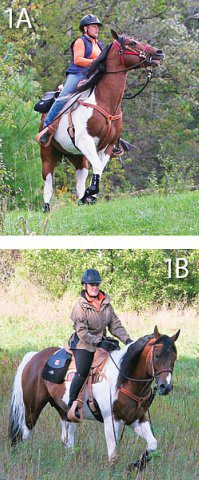
At home, warm up the horse in the arena or on the parade ground on good ground. Outside the house, find a level area near parked cars or buildings. You need enough room to lead the horse on the lunge and walk, trot and gallop in both directions.
The duration of the warm-up depends on the individual characteristics of your horse. Palm recommends lunging or under top for at least 10-15 minutes. While working on the lunge, you will be able to watch the horse from the ground, assess its mood. Make sure you control both the horse and the size of the circle. If you need help with lunging, ask your coach.
When lunging, surprise by clapping your hands unexpectedly and observe the horse’s reaction. Acceptable behavior includes play, head banging, speeding, and even goat and kick. As long as the horse is listening and responding to your commands, he is releasing his energy in a safe way, without fear.
However, if the horse shows an explosive reaction, it indicates that he is not ready to ride outdoors. Keep stretching her until she’s less reactive before heading out for a walk.
Step #2. Recognition of signals preceding a startle
Horses are designed to run away from danger, not stay put and fight. Due to this innate program, horses prefer to immediately run away from what they find scary or unusual.
You can see similar behavior in grazing horses. When they detect potential danger, they first run away from it. Then, after running a short distance, they turn and look back to appreciate it again. Horses will often approach the “scary” object to get a closer look at the sky.
Unfortunately, horses may try this practice under saddle as well. Watch your horse’s body language for the first signs of fear:
• Pricked ears and head held high. Ears pointing sharply forward (or moving quickly back and forth), head held high, and neck tense are all signs that your horse is focused on something other than you.
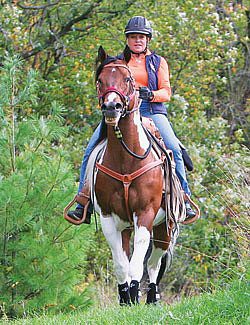
- Breathing rate. Rapid breathing is another recognizable sign that precedes fear. If your horse suddenly starts to breathe faster and/or snores or exhales heavily, it is likely that something is bothering him.
- Avoidance sign. Pay attention to any sign of avoidance (hesitation, slowing down or trying to stop, shifting to the side or trying to turn around). If you notice any of these signals, stop and regain control before your horse becomes frightened, resists, or tries to run away. Below we will explain how to do this.
Step #3. Look at a frightening object
If you notice signs of future fear, take action before your horse does. If you wait until she reacts or becomes frightened, she will become the master of the situation, not you.

To maintain control, stop your horse and keep his eyes on the intimidating object (photo 3A). Ask her to stand still and look at the object – you don’t want her to turn around and fly away. If you can maintain control, then your horse will be able to see the subject and overcome his fear or hesitation without being frightened.
Don’t clench your legs too hard and don’t pull too hard on the reins, as this will excite the horse. Keep your legs close to your sides, don’t catch them, keep light contact through the reins.
If your horse is spinning around, ask him to stand and look at the object. When she concentrates less, she will turn her head. As soon as he does this, bring his head back to a level position and encourage the horse to take a few steps forward with the leg and body (photo 3B). Then stop her. Don’t let her stop when she wants to.
When you bring the horse closer to the object, make him stand up and look again (photo 3C). She will likely shake her head back and forth to get a better look at the “threat”. Let. Give more freedom to your neck.
When your horse relaxes a bit, talk to him in a soft voice, move forward a few steps again, then ask him to stop. Always ask her to stop before she takes over and stops on her own. You need the horse to trust you and respond to your aids.
You can finish by walking/trotting forward/standing/looking several times until the horse is standing quietly next to the object and concentrating on it. Get close enough so she can sniff the item if she wants to (photo 3D).
Then move your horse so that it is parallel to the scary object (photo E). Take a few steps so that the object is at the level of her hip or behind her, and stop again. Her ears may move back and forth, or stay up, but if she can react to an object behind her without being frightened, you have succeeded.
If you return home along the same road, prepare for the next “fear activity” at the same place.
You have to start over when approaching from the other side, because the object on the other side will look different for the horse.
Step number 4. Dismounting
If you are a confident, experienced rider, you can help your horse get through future fear while in the saddle, as explained above.
But if you’re nervous or afraid that your horse might get scared or start to fight back, dismount and do the same while standing on the ground so you feel safer and your horse doesn’t catch your anxiety.
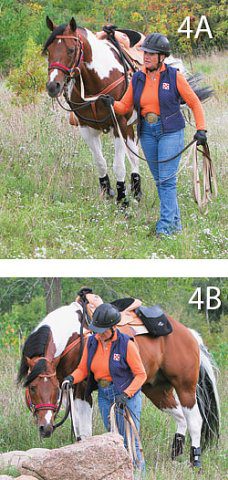
Cynthia McFarland and Lynn Palm; translation Nary Hakobyan (“Horse Dialogue”).



